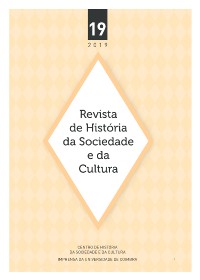Please use this identifier to cite or link to this item:
https://hdl.handle.net/10316.2/47778| DC Field | Value | Language |
|---|---|---|
| dc.contributor.author | Zhang, Minfen | - |
| dc.date.accessioned | 2020-01-21T13:28:35Z | |
| dc.date.accessioned | 2020-09-29T22:20:30Z | - |
| dc.date.available | 2020-01-21T13:28:35Z | |
| dc.date.available | 2020-09-29T22:20:30Z | - |
| dc.date.issued | 2019 | - |
| dc.identifier.issn | 1645-2259 | - |
| dc.identifier.issn | 2183-8615 (PDF) | - |
| dc.identifier.uri | https://hdl.handle.net/10316.2/47778 | - |
| dc.description.abstract | O missionário jesuíta português Tomás Pereira entrou no império chinês durante o reinado de Kangxi (1662-1722) da dinastia Qing (1644-1912) com o fim de pregar a religião cristã. Viveu em Pequim durante 37 anos, dedicando quase toda a sua vida à causa cristã e à divulgação das ciências ocidentais na China. Como os seus predecessores Matteo Ricci e Álvaro Semedo, entre outros padres jesuítas, foi não só um missionário, mas também um observador, investigador e modelador da cultura chinesa. Como tal, é natural que tenha prestado um enorme interesse e atenção ao budismo, que foi introduzido na China durante as dinastias Han e já se tinha tornado uma das principais correntes religiosas da China. Pereira estudou e observou a cultura chinesa, tão heterogénea quanto o cristianismo, do ponto de vista de um sacerdote ocidental. O presente texto pretende fazer um estudo sobre a sua compreensão do budismo da China Qing baseando-se no seu Tratado do Budismo Sínico. | por |
| dc.description.abstract | Tomas Pereira, the Jesuit missionary of Portugal, entered the Chinese mainland during the reign of Emperor Kangxi in the Qing Dynasty. He lived in Beijing for 37 years and like his predecessors, Matteo Ricci, Alvaro Semedo and other Jesuits, he was not only a missionary, but also an observer, a researcher and a builder of Chinese Culture. Buddhism, introduced into China in the Han dynasties, had become one of the major sects in China, aroused his great attention. Pereira studied and observed the Chinese culture so heterogeneous as Christianity with vision of a Western missionary. This article intends to examine and discuss his understanding of Chinese Buddhism, based on the “Treatise of Chinese Buddhism” authored by Tomás Pereira. | eng |
| dc.language.iso | por | - |
| dc.publisher | Imprensa da Universidade de Coimbra | - |
| dc.rights | open access | - |
| dc.subject | Tomás Pereira | eng |
| dc.subject | Chinese Buddhism | eng |
| dc.subject | Understanding | eng |
| dc.subject | Tomás Pereira | por |
| dc.subject | conhecimentos budistas | por |
| dc.subject | China | por |
| dc.title | Os conhecimentos do Budismo sínico do jesuíta português Tomás Pereira | por |
| dc.title.alternative | The understanding of Chinese Buddhism of the Portuguese jesuit Tomás Pereira | por |
| dc.type | article | - |
| uc.publication.collection | Revista de História da Sociedade e da Cultura vol. 19 | - |
| uc.publication.firstPage | 445 | - |
| uc.publication.lastPage | 469 | - |
| uc.publication.location | Coimbra | - |
| uc.publication.journalTitle | Revista de História da Sociedade e da Cultura | - |
| uc.publication.volume | 19 | por |
| dc.identifier.doi | 10.14195/1645-2259_19_18 | - |
| uc.publication.section | Caderno Temático Religiões e Normatividades | - |
| uc.publication.orderno | 18 | - |
| uc.publication.area | Artes e Humanidades | - |
| uc.publication.manifest | https://dl.uc.pt/json/iiif/10316.2/47778/246913/manifest?manifest=/json/iiif/10316.2/47778/246913/manifest | - |
| uc.publication.thumbnail | https://dl.uc.pt/retrieve/11838692 | - |
| item.grantfulltext | open | - |
| item.fulltext | With Fulltext | - |
| Appears in Collections: | Revista de História da Sociedade e da Cultura | |
Files in This Item:
| File | Description | Size | Format | |
|---|---|---|---|---|
| os_conhecimentos_do_budismo_s_nico.pdf | 1.46 MB | Adobe PDF |  |
Items in DSpace are protected by copyright, with all rights reserved, unless otherwise indicated.
